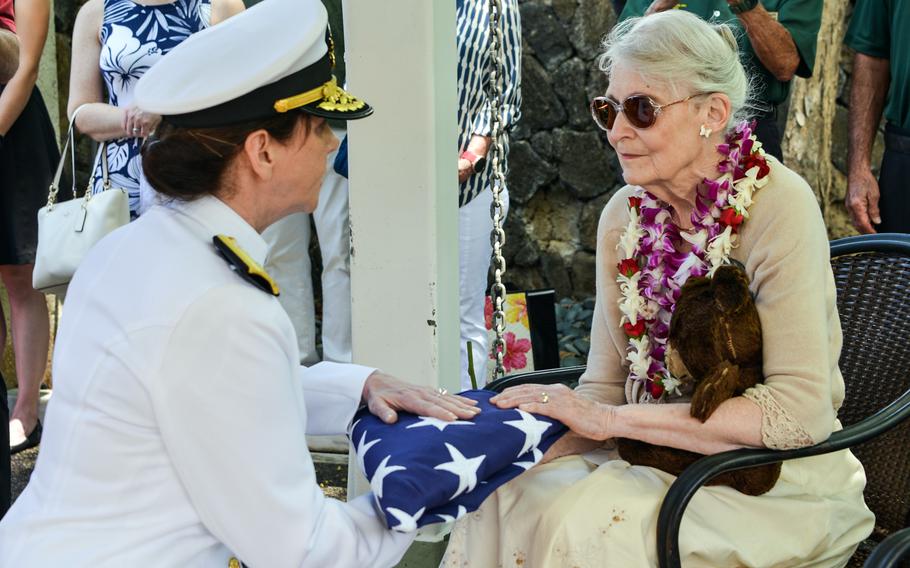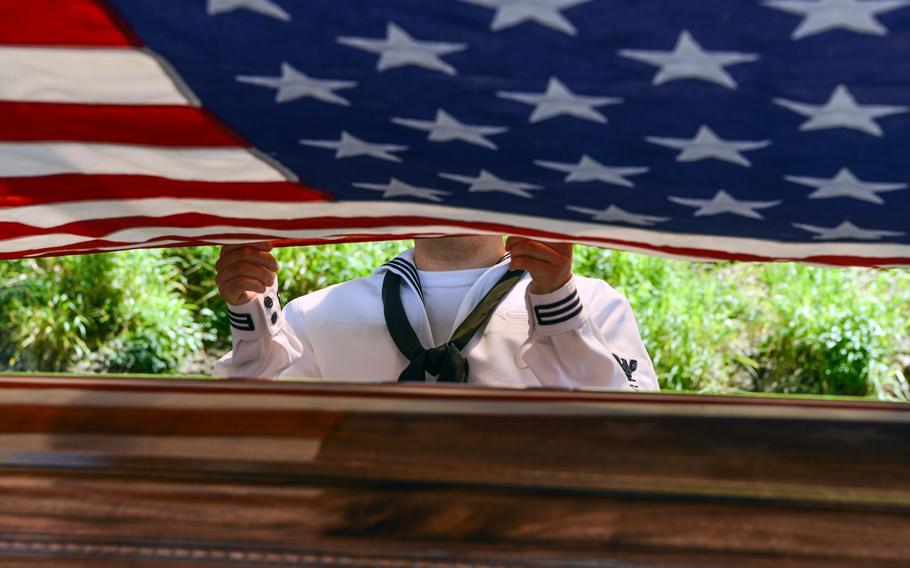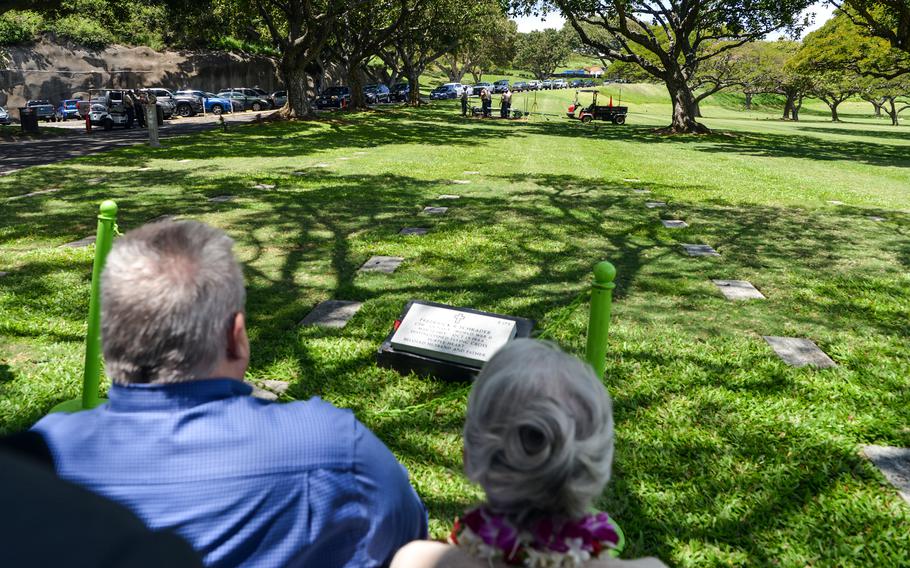
Barbara Canavan, daughter of Navy Cmdr. Frederick Schrader, is given a U.S. flag during his interment ceremony at the National Memorial Cemetery of the Pacific in Honolulu, Hawaii, April 13, 2023. (David Owsianka/U.S. Air Force)
Shot down during an attack on Toko Seaplane Base during the Battle of Formosa, now Taiwan, in 1944, Navy Cmdr. Frederick Schrader lay as an unknown in a national cemetery in Hawaii until 2022.
A native of Lawrenceville, Ill., Schrader was laid to rest again Thursday in the National Memorial Cemetery of the Pacific, this time in a plot bearing his name.
The graveside mourners included family members, including Barbara Canavan, 80, one of two surviving daughters; and a former chief petty officer, Richard Miralles, 99, who served under Schrader.
Canavan and her older sister, Judith, had not seen their father since he shipped out in summer 1944, when he purchased teddy bears for the girls and left them with his wife, Lucile Schrader, knowing he would not be home for Christmas, according to an account of Schrader’s life by Gene Hughes, a spokesman for Navy Personnel Command.

A sailor holds part of a U.S. flag during an interment ceremony for Navy Cmdr. Frederick Schrader at the National Memorial Cemetery of the Pacific in Honolulu, Hawaii, April 13, 2023. (David Owsianka/U.S. Air Force)
Schrader, 31 on Oct. 13, 1944, the day he died piloting an F6F-5 Hellcat fighter, was commander of Carrier Air Group 11 aboard the aircraft carrier USS Hornet. He led from the front, according to a news release from the personnel command in Millington, Tenn.
Schrader was shot down by anti-aircraft fire while leading a strafing attack, according to Hughes, who cited the Hornet war diary.
“According to his wingman, there was no sign of a parachute or that Schrader had been able to exit the aircraft before it crashed,” Hughes wrote in his undated biography. “Because he crashed in enemy territory, no rescue attempt was possible.”
Canavan told Hughes she celebrated her second birthday Sept. 18, 1944. Her father had been away at sea for several months.
“We were living in Long Beach, Calif., at that time when my mother received the telegram on Oct. 30 that his plane had been shot down and he was presumed dead,” she said. “She gave us the bears.”
Japanese Imperial forces recovered Schrader’s body and buried it in an unmarked grave. The American Graves Registration Service searched for a year for Schrader after the war’s end but could not identify his remains. Eventually, all the recovered remains were removed to the memorial cemetery in Hawaii in 1949.
But Schrader’s family assumed he was buried on Taiwan until a naval aviator of a later generation began researching his own Navy relative, according to Hughes.

Family members of Navy Cmdr. Frederick Schrader watch as his casket is lowered into the ground at the National Memorial Cemetery of the Pacific in Honolulu, Hawaii, April 13, 2023. (David Owsianka/U.S. Air Force)
Matt Robbins’ maternal grandfather also served aboard the Hornet during WWII, and Robbins’ research led him to an “intriguing” description of a Navy pilot lost during the Battle of Formosa.
“This file contained numerous intriguing details such as the date (13 October 1944), location (Toko Seaplane Base), circumstances (shot down by anti-aircraft fire), and, perhaps most importantly, the passage that the unknown aviator was ‘believed to be an Annapolis graduate,’” Hughes wrote.
Tellingly, only four Annapolis graduates died over Formosa, which narrowed the possible identifications, he reported.
Next, Robbins teamed up with documentary filmmakers George Retelas and Tim Hampton, whose combined research over four years led them to a set of remains designated Unknown X-136.
Eventually, the three built a strong enough case that X-136 might be Schrader. Despite being poorly preserved, they were positively identified as Schrader’s on Sept. 27, according to Hughes, who quoted Gregory Berg, lab case manager for DPAA’s scientific analysis directorate.
On Thursday, Barbara Canavan accepted the flag from her father’s casket at the graveside service.